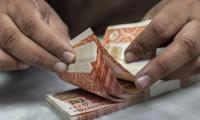WASHINGTON: U.S. retail sales recorded their biggest increase in seven months in July as consumers boosted purchases of motor vehicles and lifted discretionary spending, suggesting the economy continued to gain momentum early in the third quarter.
Retail sales for June and May also were revised higher, which should help to assuage concerns about a slowdown in consumer spending at the start of the year. Tuesday´s upbeat report from the Commerce Department likely keeps the Federal Reserve on course to raise interest rates again in December.
"American shoppers flocked to the malls and even department stores in July, suggesting consumers are well-positioned to propel the economy forward in the second half of the year," said Sal Guatieri, a senior economist at BMO Capital Markets in Toronto.
Retail sales jumped 0.6 percent last month, the largest gain since December 2016. June´s retail sales were revised to show a 0.3 percent gain instead of the previously reported 0.2 percent drop.
Economists had forecast retail sales increasing 0.4 percent in July. May´s retail sales were revised to show no change instead of the previously reported 0.1 percent dip. Retail sales increased 4.2 percent in July on a year-on-year basis.
Excluding automobiles, gasoline, building materials and food services, retail sales surged 0.6 percent last month after an upwardly revised 0.1 percent gain in June. These so-called core retail sales, which correspond most closely with the consumer spending component of gross domestic product, were previously reported to have dipped 0.1 percent in June. The report helped to shift investors´ attention from recent weak inflation data as markets try to forecast the Fed´s next policy move.
The U.S. central bank has raised rates twice this year and economists expect it will announce a plan to start unwinding its $4.2 trillion portfolio of Treasury bonds and mortgage-backed securities in September.
Prices of U.S. Treasuries were trading lower on Tuesday while U.S. stocks were mixed. The dollar was stronger against a basket of currencies. Consumer spending, which accounts for more than two-thirds of U.S. economic activity, increased at a 2.8 percent annualized rate in the second quarter.
That boosted GDP growth to a 2.6 percent rate in the April-June period. But persistently sluggish wage growth has pushed Americans to dip into their savings to fund spending. Economists say wage growth has to pick up to sustain consumer spending. Annual wage growth has struggled to break above 2.5 percent.
The saving rate has dropped to 3.8 percent in the second quarter of this year from a rate of 6.2 percent in the second quarter of 2015. Low savings and tepid wage growth suggest households would need to borrow to maintain spending.
"The decline in the saving rate, however, raises some longer-term concerns about consumer spending," said Michael Feroli, an economist at JPMorgan in New York. "Savings can´t drop indefinitely and future consumption growth will need to rely on stronger income growth." For now, the near-term outlook for the economy is brightening.
In a second report on Tuesday, the New York Fed said its Empire State general business conditions index climbed 15.4 points to 25.2 in August, the highest level in nearly three years. Manufacturers in the region reported a jump in new orders and said they were taking longer to deliver goods and that inventories were declining.
Retail sales in July were lifted by a 1.2 percent surge in motor vehicle sales, the biggest rise since December 2016, after advancing 0.9 percent in June. Faced with a huge inventory of unsold cars, auto dealerships are resorting to hefty discounts to attract buyers.
Prices for new motor vehicles recorded their biggest drop in nearly eight years in July and have decreased for six straight months. Prices could decline further as a third report from the Labor Department on Tuesday showed the cost of imported motor vehicles fell in July for the second consecutive month. Retail sales in July were also buoyed by a 1.2 percent increase in receipts at building material stores.
This handout photo released by the Iraqi prime minister´s office on April 1, 2023, shows a view of installations at...
P@SHA Chairman Zohaib Khan was the esteemed Chief Guest at Aptech 2023. — X/PASHAORGKARACHI: Muhammad Zohaib Khan,...
PSX marked the listing of the Mahaana Islamic Index Exchange Traded Fund with a gong ceremony on aPRIL 23, 2024. —...
FPCCI Regional Chairman and VP Zaki Aijaz while speaking during a round table discussion on the challenges and...
This representational image shows Gold bars. — AFP/FileKARACHI: Gold prices in the local market fell by Rs7,800 per...
Security personnel walk past the US Federal Reserve building in Washington, DC on Oct 22, 2021. — AFPNew York:...







